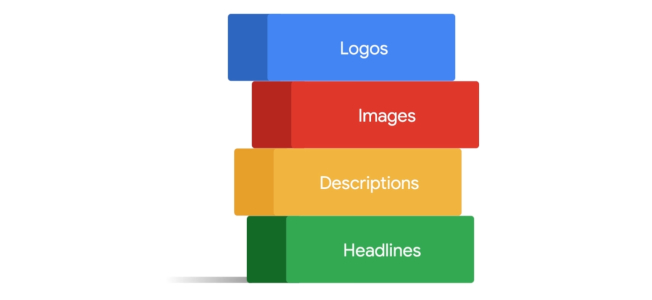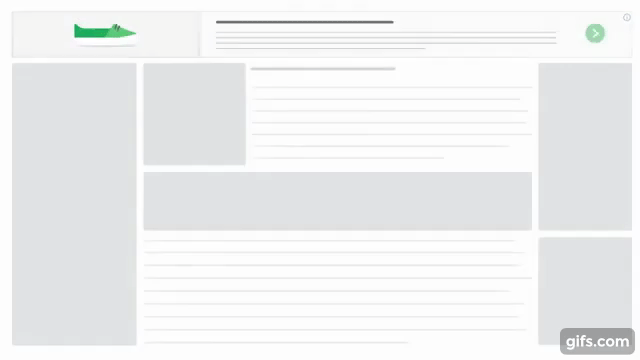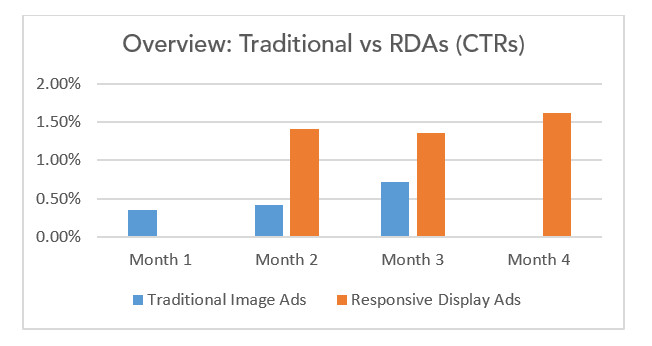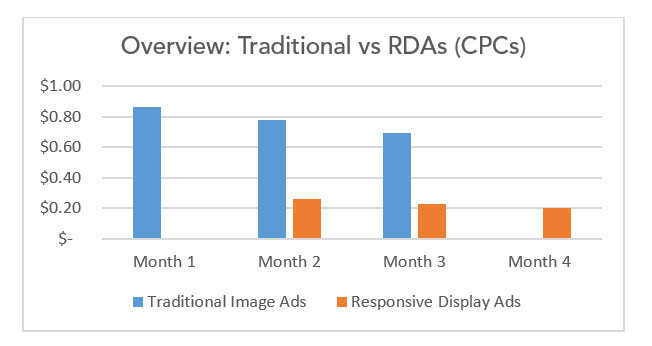It almost goes without saying that the type of ads you choose to run on more than three million websites across Google properties will have an impact on your campaign’s performance. But that doesn’t mean format selection should be a hugely complex process.
In fact, it would appear that Google’s default format might actually be the best option for the Google Display Network: responsive display ads (RDA) have been shown to drive the greatest performance in terms of both reach and scale.
But how, exactly, do RDAs work? More importantly, how do you deploy them effectively? Let’s take a closer look.
What is an RDA?
Powered by machine learning, RDAs allow advertisers to upload up to 15 images, five headlines, five descriptions, and five logos which are automatically adjusted (size, appearance, combination, format) to fit any available ad space that works best based on past ad performance history.

Currently, Google will also split test ad copy and image variations to find the best combinations to boost performance. But the effectiveness of the final assets is not 100% down to the algorithm. If you want to end up with quality ads that perform, each component part has to be up to the task.
Creative best practices for RDAs
Let’s just come out and say it: imagery is the single most important element of responsive display ads. Advertisers have to deploy creative assets that are not only eye-catching, but effectively help their audiences understand the product/service, brand, and value proposition. That’s why DAC’s Media team works closely with in-house designers to generate high-quality, on-brand imagery for each of our campaigns.
Images intended to be used in RDAs cannot be visually skewed, blurry, or have a strobing effect. Neither should they have any overlaid logos, text, or buttons—that’s Google’s job. We use static images within our RDAs, but it is important to note that video assets are also engaging for users.

In terms of copy, RDAs allow advertisers to provide up to five short headlines within 30 characters, one long headline within 90 characters, and up to five descriptions to elaborate on the headlines and articulate the value proposition clearly. We always ensure that all RDA copy assets are unique for maximum performance and provide all possible copy to reduce costs as the campaign ran.
To decide on the most appropriate and effective tone, refer to your best results in SEM. We regularly take inspiration from our best-performing ads in conventional search campaigns to craft headlines and descriptions that really resonate with our target audiences.
RDAs in action
In our most recent client campaign, RDAs outperformed conventional display ads in multiple key metrics, including site traffic, CTR, CPC, and store visits. Specifically, RDAs generated +314% CTRs and -73% CPCs compared to traditional ads. With 3% lower spends, we were able to achieve +264% site traffic and +209% store visits (conversions) using RDAs instead of traditional ad formats.


Future improvements and insights
Iterative improvement is the name of the game in digital media, so although these outrageous results represent an excellent start, they are by no means the end of the story. For this particular account, we had previously used traditional display ads only. Having observed the impact of RDAs, with significant improvements in both CTR and CPC, it became clear that they should be carefully implemented across all of our client’s lines of business.
Of course, one of the RDA format’s main strengths is that it lends itself perfectly to A/B testing. In this campaign, we are determining which call to action drives better performance—”Learn More” or “Visit Site”—as the first test in an ongoing optimization program that will also involve imagery and ad copy.
Our RDA checklist
- All images must meet basic quality standards
- Include the recommended number of assets and copy
- All copy should be unique
- Swap in new creative assets as promotions change
- Commit to ongoing A/B testing and optimization
Could an RDA campaign drive transformative growth for your brand’s paid media efforts? There’s really only one way to find out… Let’s talk!




